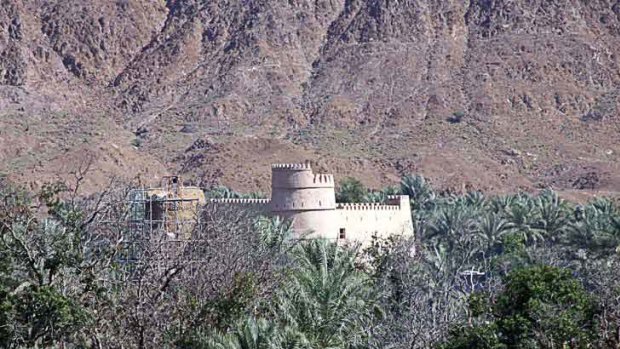
Quiet contrast ... Al Bithna Fort in its tree-studded surroundings.
It might lack the glamour of its neighbours but Fujairah has a verdant charm of its own, writes Joanna Hall.
IT IS early on a warm winter morning as our bus speeds along the highway. To the east of us lies the Indian Ocean, its balmy waters sparkling in the sunlight, while the backdrop to the west is the rugged Hajar Mountains, their limestone peaks subtly changing colour with every twist in the near-empty road.
I'm in Fujairah, a less well-known member of the United Arab Emirates, which straddles the eastern edge of the country on the Gulf of Oman.
Its name means "where the sun rises" in Arabic and, as I soon discover, it strikes a bold contrast with its more glitzy neighbours.
Instead of stark desert, Fujairah has lush green valleys, mountain ranges dotted with oases that tumble into the ocean and empty, sandy beaches. An unexploited jewel of landscapes, it also has an impressive collection of forts and castles offering a glimpse into its ancient past.
I am in the Persian Gulf on a cruise and along with visiting Abu Dhabi and Dubai, our ship has ventured into a few lesser-known Arabian ports of call, Fujairah being one. Our day-long exploration begins with a stop at one of its most revered holy sites, the Al Bidyah Mosque.
Located at the side of the road between Dibba and Khor Fakkan, it's the oldest mosque in the UAE, dating to 1446.
It has an unusual and fragile architecture, constructed of mud bricks and plaster with four domes supported by an internal pillar and no minaret.
Our next destination is a lookout over Fujairah's Wadi Wurayah, a scenic spot and protected region of environmental importance.
To get there our bus follows the coast, passing small villages, beaches bustling with fishermen and Dibba Mosque, with its distinctive tiled dome.
Eventually we turn inland towards the lower ranges of the Hajar Mountains.
On the way, our guide gives us an insight into the history of the emirate and, more importantly perhaps, its significance today. Although it's one of the poorer states, it has a key location on the Gulf of Oman outside the Strait of Hormuz, the narrow and strategically important channel separating Oman and the UAE from Iran to the north.
Progress has seen Fujairah succumb to development but it clings to its past as one of the less relaxed emirates. Tourists must obey sharia laws: consumption of alcohol is strictly controlled, women need to cover up and kissing in public is frowned upon.
Soon we are at the lookout. Wadi is an Arabic word for valley and as scenic spots go this lush region isn't what you expect of a country on the Arabian peninsula.
Besides valuable water resources, Wadi Wurayah is also home to more than 300 plant species and a variety of insects and animals. It's also rich in archaeological treasures.
After time to stretch our legs and take photographs, we head to Masafi Friday Market, or the Souq al Juma as it is known locally. Located on the Dubai-Fujairah road, local traders gather daily to sell everything from rugs, carpets and earthenware to plants and food.
Unlike traditional souqs, which often occupy chaotic laneways, this market flanks either side of the highway, stretching for 250 metres.
It's a great opportunity to mingle with the locals and learn some good-natured bargaining tips, as heavy trucks hurtle past transporting goods from Fujairah's port to the other emirates.
On the way to Fujairah fort and museum, we stop briefly to photograph the famous Al Bithna Fort. Built in 1735, it once stood watch over the strategic route across the Hajar Mountains through Wadi Ham and was one of the most important fortresses in the eastern part of the UAE.
Another important structure, and one of the country's most photographed, is Fujairah Fort, our last stop. The building you see today, however, is a replica. Standing on a hill and dating back to 1670, it was badly damaged in the early 20th century by the British but has been renovated to its former glory.
We arrive back at the port of Fujairah as the sun begins to set, the outline of the Hajar Mountains lingering in the softening light. Unlike red-hot Dubai or flamboyant Abu Dhabi, Fujairah's mood is decidedly quieter, providing both respite and cultural contrast.
The writer travelled courtesy of Royal Caribbean Cruises, Emirates and Arabian Adventures.
Trip notes
Getting there
Emirates operates 70 flights a week to Dubai from Australia, including three daily services from Sydney. 1300 303 777, emirates.com. Fujairah is about 150 kilometres, or two hours by car, east of Dubai Airport. A taxi should cost about 300 dirham ($80).
Cruising there
Royal Caribbean's Brilliance of the Seas operates seven-night cruises between November and March, priced from $649 a person, twin share. 1800 754 500, www.royalcaribbean.com.au.
Touring there
Arabian Adventures offers tours in and around Fujairah and the UAE, arabian-adventures.com.
Four things to know
1 Bartering is almost compulsory but avoid getting into an argument with locals over prices.
2 Fujairah has a shopping festival, which started this year and will run annually, taking place for 40 days between March 24 and May 2.
3 Enjoy gahwa, a type of Arabic coffee derived from the Bedouin culture, which is served with dates for sweetening.
4 Popular dishes to try include harees, a dish of boiled, cracked wheat and meat or chicken, kabees or pickled turnips, and gaimat, syrupy dough balls that are especially popular during Ramadan.
Sign up for the Traveller Deals newsletter
Get exclusive travel deals delivered straight to your inbox. Sign up now.